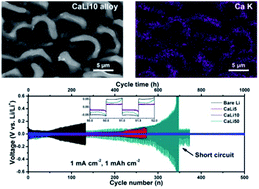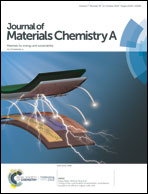A dual-phase Li–Ca alloy with a patternable and lithiophilic 3D framework for improving lithium anode performance†
Abstract
The growth of lithium (Li) dendrites hinders the application of Li metal anodes in rechargeable Li batteries. Herein, a dual-phase alloy of Li–Ca is proposed to replace Li metal as an advanced anode, which is composed of a Li metal phase and a CaLi2 alloy phase. The three dimensional (3D) CaLi2 alloy framework forms regular patterns via phase segregation while cooling down the molten Li–Ca alloy in a facile one-step fusion fabrication process, where pattern shape and mechanical stability change with the atomic ratio of Ca to Li. The porous CaLi2 alloy framework is functionalized as a lithiophilic current collector in the lithiation process, featuring enhanced structural stability and suppressed Li dendrite growth. Consequently, the electrochemical performance of a dual-phase Li–Ca alloy anode with microsized patterns is significantly improved with a Li metal phase as the reservoir providing reversible capacity. This dual-phase Li alloy with a regularly arranged 3D lithiophilic framework provides a new solution for lithium metal batteries.



 Please wait while we load your content...
Please wait while we load your content...